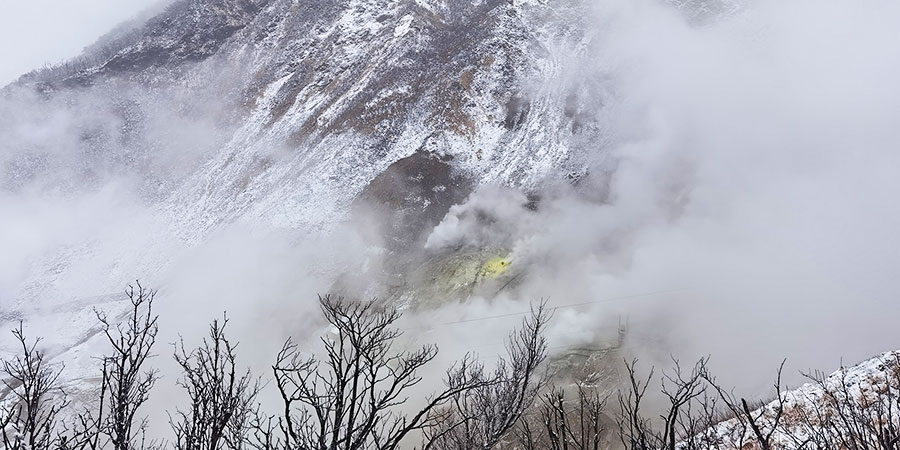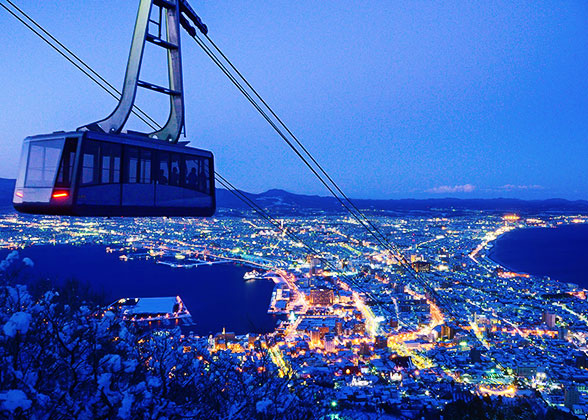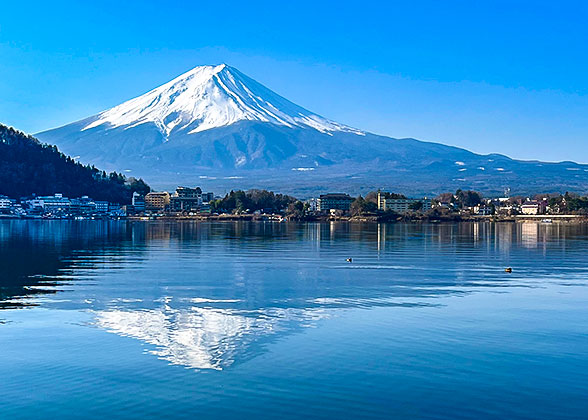Noboribetsu Hell Valley
Noboribetsu Hell Valley is a crater relic with a diameter of 450 meters (490 yards), giving out volcanic gas all year round, so the air there is full of sulfur. And its hot spring water output is as high as 3,000 liters per minute, making it the largest hot spring source in the Noboribetsu. The white smoke that permeates all year round and the sound of running water underground make people feel like they are in hell, so it is named “Hell Valley.”

Noboribetsu Hell Valley
|
At the entrance, there is a small shrine and a statue of two ghosts, one blue and one red. After entering the valley, you will see the entire valley being eroded by lava, with white gas bubbling up everywhere, and black rocks that have been scorched by molten lava. You will also find several springs and flowing water, and sometimes even boiling lava and sulfur solutions, which are quite impressive.
Where to Go in Noboribetsu Hell Valley
1. Jigokudani Observation Deck
From the Jigokudani Observation Deck, you can see the entire valley. In addition, this place is rated as one of the “100 Famous Maple Leaf Spots in Japan.” From mid-October to late October every year, the red maple leaves on surrounding slopes are intoxicating, creating a unique and beautiful scene together with the floating mist.
|
|
|
2. Iron Spring Pond
The Iron Spring Pond is the largest spring in Noboribetsu Hell Valley. It is an intermittent spring that gushes periodically, and it takes about 50 seconds for it to go from calm to boiling. The water temperature of this spring can reach up to 80°C (176℉), and a raw egg can be cooked in about 10 minutes. Please note that the water will splash very high when boiling, and there will be hot steam blowing around, so please keep a safe distance.3. Oyunuma
Oyunuma is located deep in the Noboribetsu Hell Valley. It is a natural hot spring lake with a unique blue color. The hot spring water here is relatively hot, and the white steam produced is particularly beautiful on the blue water. Walking along the lake, you can smell the sulfur and see the source of the hot springs that are always smoking and bubbling. In addition, there are yellow balls of sulfur floating on the lake, which are particularly conspicuous.
|
|
|
4. Oyunuma Brook Natural Footbath

Oyunuma Brook Natural Footbath
|
Hiking Route in Noboribetsu Hell Valley
Jigokudani Observation Deck ➡ Iron Spring Pond ➡ Jigokudani Haridashi Lookout ➡ Oyunuma Lookout ➡ Oku-no-Yu ➡ Oyunuma ➡ Oyunuma Brook Natural FootbathThe entire hiking takes about 2 hours.

A hiking trail in Noboribetsu Hell Valley
|
Best Time to Visit Noboribetsu Hell Valley
The best time to visit is in the fall when the maples turn red and in the winter when the snow covers the valley. By the way, the best time of day to visit is at night, when the lights make the Noboribetsu Hell Valley look even more mysterious.Tips for Visiting Noboribetsu Hell Valley
1. When entering the scenic area, you will smell a distinct or even pungent odor. You can prepare a mask in advance.2. The fumaroles in the valley spew out hot gases from time to time. When walking, do not leave the dedicated pedestrian paths at will to avoid danger.
3. To be safe, follow other regulations and instructions in the scenic area.
Admission Fee:
Free admission
Opening Time:
All day
How to Get to Noboribetsu Hell Valley
First, you should take the JR train to Noboribetsu Station.Then take a bus bound for “Noboribetsu Onsen” on the right side of the exit. It costs 350 yen per person and takes about 20 minutes to reach the Noboribetsu Onsen Station.
Get off the bus and follow the gentle slope upwards. You can see the entrance to the Yuzawa Shrine. Turn right, and it will take only a few minutes to reach the entrance to Noboribetsu Hell Valley.
|
|
|
Nearby Attractions
1. Noboribetsu Onsen
Noboribetsu Onsen is located at the foot of the Noboribetsu Hell Valley, and there are many hot spring hotels. The hot spring water here is all from the natural hot springs of Noboribetsu Hell Valley, and the water quality is very good. It has been listed as one of the rare hot springs in the world. After your hike from Noboribetsu Hell Valley, a hot spring bath will be especially enjoyable.

Onsen Hotel in Noboribetsu
|
2. Noboribetsu Bear Park
It takes about 7 minutes by ropeway from Noboribetsu Onsen to the Noboribetsu Bear Park. There are about 1,600 Japanese brown bears here. This bear park is the largest bear park in the world and has the only bear museum in the world.3. Lake Toya ➡ Noboribetsu Hell Valley ➡ Lake Shikotsu

Lake Shikotsu
|




